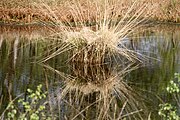Eternal sea
| Eternal sea | ||
|---|---|---|

|
||
| The Eternal Sea, October 1987 | ||
| Geographical location | East Frisia , Lower Saxony | |
| Location close to the shore | Eversmeer | |
| Data | ||
| Coordinates | 53 ° 32 '44 " N , 7 ° 25' 54" E | |
|
|
||
| Altitude above sea level | 8.5 m above sea level NN | |
| surface | 91 ha | |
| length | 1.65 km | |
| width | 870 m | |
| volume | approx. 2,000,000 m 3 | |
| Maximum depth | 3 m | |
| Middle deep | 2 m | |
|
particularities |
Largest high moor lake in Germany |
|

|
||
| Area map (2006) | ||
The Eternal Sea is approximately 91 hectares (0.91 square kilometers) of water surface the largest Hochmoorsee Germany . Its surface is about 8.5 m above sea level . The lake is bordered by an extensive complex of unused areas that still show the actual high moor profile and, together with the water, form the 1180 hectare nature reserve Ewiges Meer and its surroundings .
location
The nature reserve lies in the border area between the districts of Wittmund and Aurich near the village of Eversmeer in East Frisia . It belongs to the Nenndorfer high moor on the apex of the Oldenburg-East Frisian Geestrücken and represents the core zone of the approximately 33 square kilometer moor complex Great Moor near Aurich .
description
The lake, two to three meters deep, is around 1,650 m long and sometimes almost 900 m wide. The formation of the water surface is attributed to the merging of several high moor bodies (Berumfehner, Tannhausener and Meerhusener moor), which prevented the runoff of rainwater and thus led to the open water. Each of these bogs had the convex surface typical of raised bogs .
In the central raised bog area, natural development largely dominates, and the Bult-Schlenken complexes characteristic of arched rain bogs are formed locally . The lack of nutrients and the acidity of the bog water allow only specialized plant or animal life to flourish. Rosemary ( Andromeda polifolia ) Ordinary Cranberry ( Vaccinium oxycoccos ), bog lily ( Narthecium ossifragum ) Ordinary deergrass ( Trichophorum cespitosum ) Rundblättriger, Middle and Langblättriger sundew ( Drosera spec.) And White beak-sedge ( Rhynchospora alba ) are typical flowering plants, with various peat mosses and cotton grasses ( Eriophorum spec.) are associated.
The surrounding, predominantly open landscape is characterized by bog heaths made from broom and bell heather ( Calluna vulgaris and Erica tetralix ) and populations of pipe grass ( Molinia caerulea ). The patchy woody vegetation consists mainly of bog birch ( Betula pubescens ), gray willow ( Salix cinerea ) and mountain ash ( Sorbus aucuparia ). Since the three originally separate bog bodies grew together relatively recently, the peat layer around the sea is sometimes only one meter thick.
In addition to the main body of water, there are other so-called bog eyes such as the "Kleine Eversmeer" (currently approx. 3.4 ha of water after partial silting), the "Dobbe" (8.7 ha including siltation zones) and the two "Krickmeere" (0, 6 and 0.35 ha), as well as numerous larger water-filled gullies created by peat extraction . This is where the strictly protected, last Black Tern in East Frisia breed .
protection
Since the beginning of the 1980s there has been a 1.8 kilometer long boardwalk on the northern edge, which was supplemented by a moor nature trail in 2000. The south of the area is now inaccessible to visitors. The state moor management has been implementing measures since 1979 to raise the water level in the area and thus to improve the conditions for moor renaturation .
Cultural and historical significance
The moor area around the Eternal Sea has revealed archaeological finds over the course of time, for example the bog corpse of Bernuthsfeld or the boardwalk in the Meerhusener Moor near the village of Tannenhausen. The sites in Walle (the well-known plow from Walle ) are in the original area of extent of this moor and the megalithic grave of Tannenhausen (popularly called butter, bread and cheese after the shape of the stones preserved ) is very close to it.
Picture gallery
See also
literature
- Harm Poppen: Eternal Sea nature reserve. Publishing house Cl. Mettcker & Sons, Esens 1991, ISBN 3-87542-009-8 .
- Ernst Andreas Friedrich : Natural monuments of Lower Saxony. Landbuch-Verlag, Hannover 1980, ISBN 3-7842-0227-6 .
Web links
- Eternal Sea Nature Reserve website
- "Ewiges Meer" nature reserve in the database of the Lower Saxony State Office for Water Management, Coastal and Nature Conservation (NLWKN)
- Documentation of the condition and development of the most important lakes in Germany of the TU Cottbus, part 4: Bremen and Lower Saxony (PDF, 500 kB)







